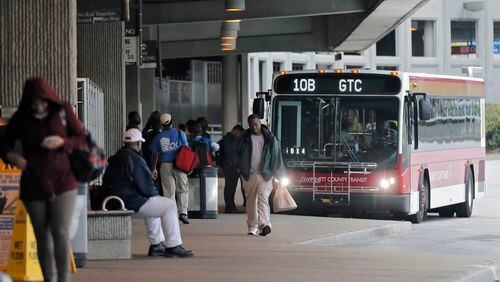Gwinnett County is expected to add nearly half a million people in the next two-plus decades. If projections hold, those new residents will push Gwinnett past Fulton as Georgia's most populous county.
Commission Chairman Charlotte Nash knows all that, and she believes Gwinnett needs more transit options. A transportation system able to serve the county’s still-growing populace must be planned for, she said. And the county will need buy-in from its long-reticent — but rapidly evolving — residents.
Because it could be now or never.
"Some people think [transit expansion] can happen a lot quicker than it can," said Nash, who wants the county to have some kind transportation referendum on the ballot in 2018. "… It's going to be a long, drawn-out process. And if we don't get started soon, it means it's just going to be that much harder to get done."
Gwinnett recently began in earnest a comprehensive transit development plan, a months-long study to determine what kind of transit additions might be most feasible, and palatable, for the county.
The Atlanta Regional Commission projects that, by 2040, Gwinnett will boast more than 1.35 million residents, an influx of nearly 500,000 people. Projections show the county only getting denser along already crowded corridors like I-85, Ga. 316, Buford Highway and Peachtree Industrial Boulevard.
Like many suburban counties, Gwinnett has resisted transit for decades, citing fears of increased crime or decreased property values. Voters rejected proposals to join the MARTA system in 1971 and 1990 and, in 2012, helped shoot down a regional sales tax proposal that would have provided money for transit and transportation projects.
While there are still many Gwinnettians dead-set against any kind of new transit, Nash believes the group of folks willing to even broach the subject is “bigger now than it’s ever been.” About 44 percent of Gwinnett residents that participated in a 2016 survey from the ARC said expanded public transit was the best long-term solution to the region’s traffic woes.
It’s not only current conditions that Gwinnett should consider when deciding what, if any, new transit options should be provided, officials said — because 2040 isn’t as far away as it sounds.
“You need to start doing the planning now, to know what’s priority so you can have the infrastructure in place,” John Orr, manager of the ARC’s transportation section, said.
“I think the county certainly recognizes that, with the amount of population growth, that they need to take a fresh look at some of the possibilities for transit moving forward,” he added.
Part of Gwinnett’s comprehensive transit plan process, which started last month with stakeholder meetings, will be educating voters on what various types of projects might cost.
The county estimates that heavy rail, for instance, would run at least $250 million per mile. Light rail could fetch $150 million per mile. Bus rapid transit, buses that operate in dedicated lanes and make fewer stops than local routes, would likely cost more in the area of $25 million per mile.
Those rough figures don’t include operating costs.
Funds from generic special-purpose local option sales taxes — which Gwinnett voters have approved during multiple referendums, including one in November — would cover only capital expenses. As state law is currently written, special single-county transportation SPLOSTs could be used to fund operating costs but are permitted to last for only five years.
There’s been talk at the Georgia General Assembly of extending that time period, but the current law is a dicey proposition for something like transit funding, which Nash called a “forevermore commitment.”
“I still run into people who will kind of put together a scenario for a lot of improvements,” said Alan Chapman, the director of the Gwinnett Department of Transportation. “And we’ll really get into the details of the cost and maybe the light bulb goes off that it may not be affordable as they thought it was.”
Compilation of the county’s comprehensive transit plan will shift into high gear later this summer, Chapman said, with an online survey and county “bus tour.”Officials will stop at community events and gauge opinions by speaking to locals on tap. A phone survey is also a possibility.
Officials hope to create an actual list of recommendations to present for even more public input sometime in early 2018. Nash's hope is that some kind of referendum on some kind of transit expansion would be on the following November's ballot.
“Quite honestly, as part of this process, we’re looking for public participation. But we’re also looking at it as a chance to educate the public,” Nash said. “… And part of that will [help create] a more realistically founded list of recommendations.”
Gwinnett has local bus routes and a handful of commuter buses that run from local park-and-rides to various places around Atlanta. But Orr, the ARC manager, said the county still has “an awful lot of infrastructure needs” moving forward.
“A lot of it is going to boil down to what’s cost-effective and right for their community,” he said. “I think that’s something they’re going to have to be wrestling with the rest of the year.”
About the Author








